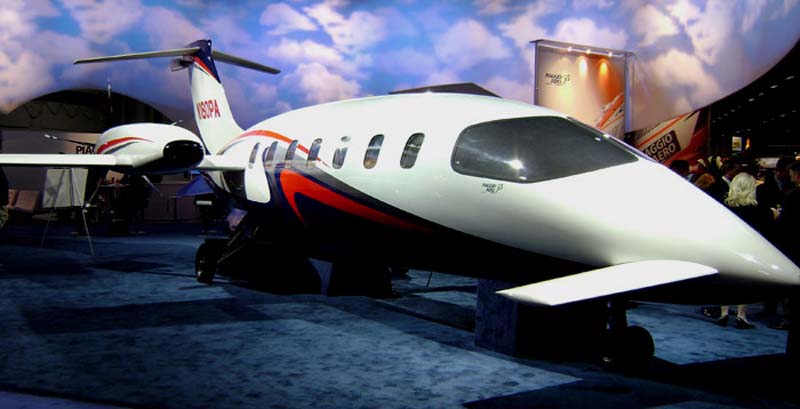| Piaggio | ||||||||||
|
P.180 Avanti |
||||||||||
 |
||||||||||
|
Photo: Robert Deering
2/15/2013 San Francisco International Airport San Francisco, California |
||||||||||
|
The
Piaggio P180
Avanti is
an Italian twin-engine turboprop
aircraft produced
by Piaggio Aero. It seats up to nine
passengers in a pressurized cabin, and may
be flown by one or two pilots. The design
uses a small forward wing and a main wing
combination that places the wing spars
outside of the passenger cabin area.
Although the front wing resembles a canard
configuration, a conventional horizontal
stabilizer on the tail provides longitudinal
stability and pitch trim. It features a
lifting laminar flow fuselage and has
engines in pusher configuration. The Avanti's turboprop engines are placed on a mid-fuselage, high aspect ratio wing, located behind the cabin. The design utilizes both a T-tail and a pair of small, fixed anhedral forward wings that have flaps. The arrangement of the wing surfaces allows the horizontal stabilizer to maintain nearly neutral lift, as opposed to a conventional configuration, where the horizontal stabilizer creates a downward force to counteract the nose-down moment generated by the center of gravity being forward of the aircraft neutral point. This was patented in 1982 as "Three-Lifting-Surface Configuration" (3LSC). The Avanti II's forward wing flaps automatically descend in concert with main wing flaps. This reduces the force the horizontal stabilizer has to produce to compensate for the pitch-down effect of the wing flap deflection. This allowed both the stabilizer and the main wing size to be reduced for efficiency. Scaled Composites Triumph was also built with this approach and for this market, but did not go to production. The forward wing angle of incidence relative to the fuselage is set so it stalls before the main wing, producing an automatic nose-down effect; its five-degree negative dihedral keeps the stream wash interference clear of the engine inlets, the main wing and the horizontal stabilizer. Cabin cross-section varies continuously along the length of the aircraft; the shape approximates a NACA airfoil section, and the slowly changing curve helps prolong laminar flow on the front of the fuselage. Piaggio claims the fuselage contributes up to 20% of the Avanti's total lift with the front and rear wing providing the remaining 80%. Due to the unusual fuselage shape, the mid cabin is considerably wider than the cockpit. The front and rear airfoils are custom sections designed by Dr. Jerry Gregorek of Ohio State University's Aeronautical and Astronautical Research Laboratory to achieve a drag-reducing 50% laminar flow at cruise. The company claims the overall design of the P180 Avanti II enables the wing to be 34% smaller than on conventional aircraft. The P180 is known for its fuel efficiency relative to small turbojets that fly in the same speed and altitude range. Flight International stated: "The Avanti has no direct turboprop competitors, its closest jet rivals are the Raytheon Premier I and the Cessna Citation CJ2+... Piaggio says low-drag laminar flow is maintained to around 50% of wing chord, compared with around 20-25% for conventional tractor turboprops where propeller wash disturbs the airflow over the wing... specific air range at high altitude is 3.4km/kg (0.84nm/lb) compared with around 2km/kg (0.49nm/lb) for current jets or 2.7km/kg (0.67nm/lb) for other turboprops." By this estimate, mileage is 70% better per-fuel-unit than comparable jet aircraft, however this extreme efficiency is achieved only at a relatively slow 315 KTAS and FL410. P180 Avanti II Specifications now show slightly lower numbers for specific range of 3.1 km/kg (0.76 nm/lb). As the propeller disks and engine exhausts are located behind the cabin, the interior noise is lower than conventional turboprop aircraft. Piaggio quotes 68 dBA. However, due to the strongly disturbed flow in which the pusher propellers operate, the exterior noise is higher than desirable. The exterior noise level and its higher pitched sound has been shown to be the result primarily of the interaction of the turbine engine exhaust flows and the 5 bladed pusher props (est. +9 dB). The reduction of external noise is an active research topic at Piaggio. On take off, the Avanti has been measured at 81.9 dBA, slightly lower than the Beechcraft King Air at 82.8 dBA. This is below FAA stage 3 noise limits which set a maximum of 89 EPNdB for take off. However, the P180 has been the subject of noise complaints at airports such as Naples Municipal Airport, Florida, where the airport authority determined it was the noisiest aircraft using that facility. Alan Parker, chairman of the Naples Municipal Airport Authority's technical committee, described the Avanti as "irritating loud" and compared the high pitched sound "to fingernails on a chalk board". |
||||||||||
|
||||||||||
|
||||||||||
